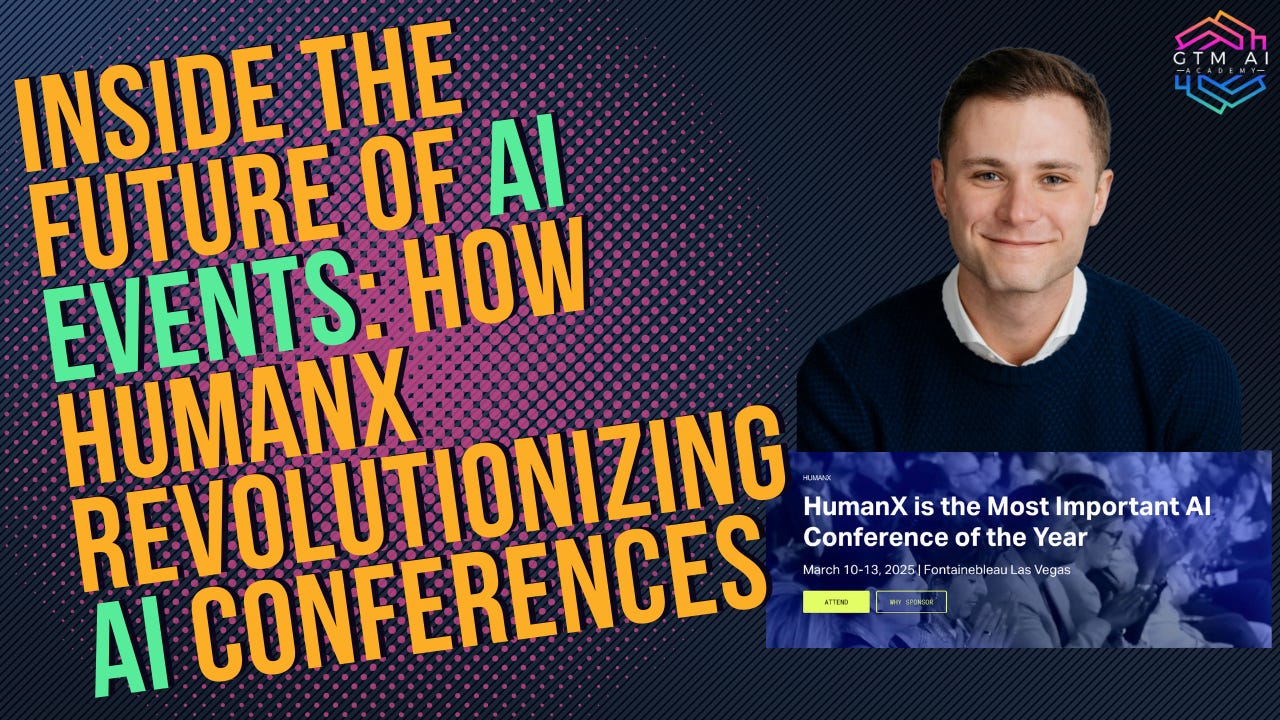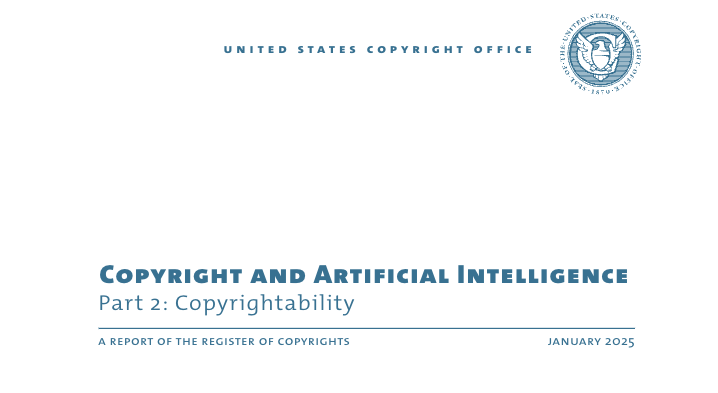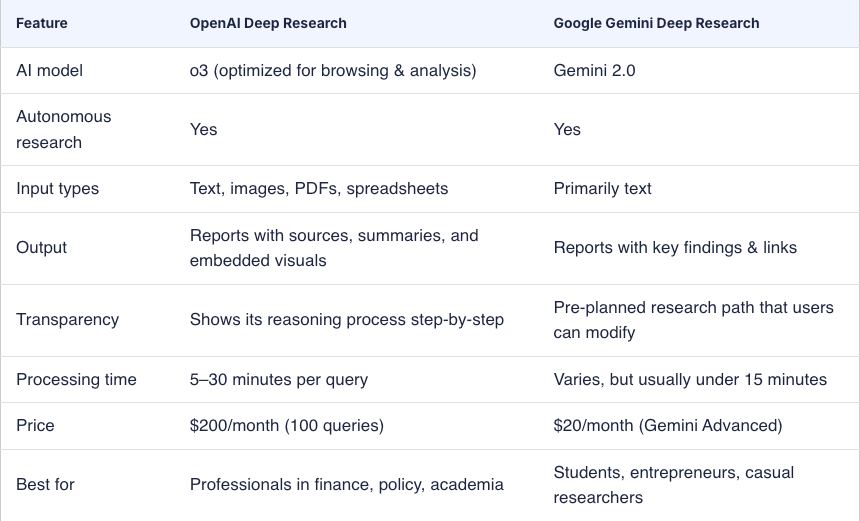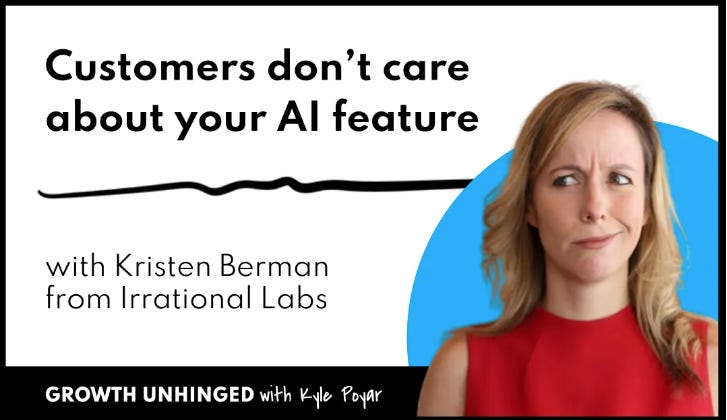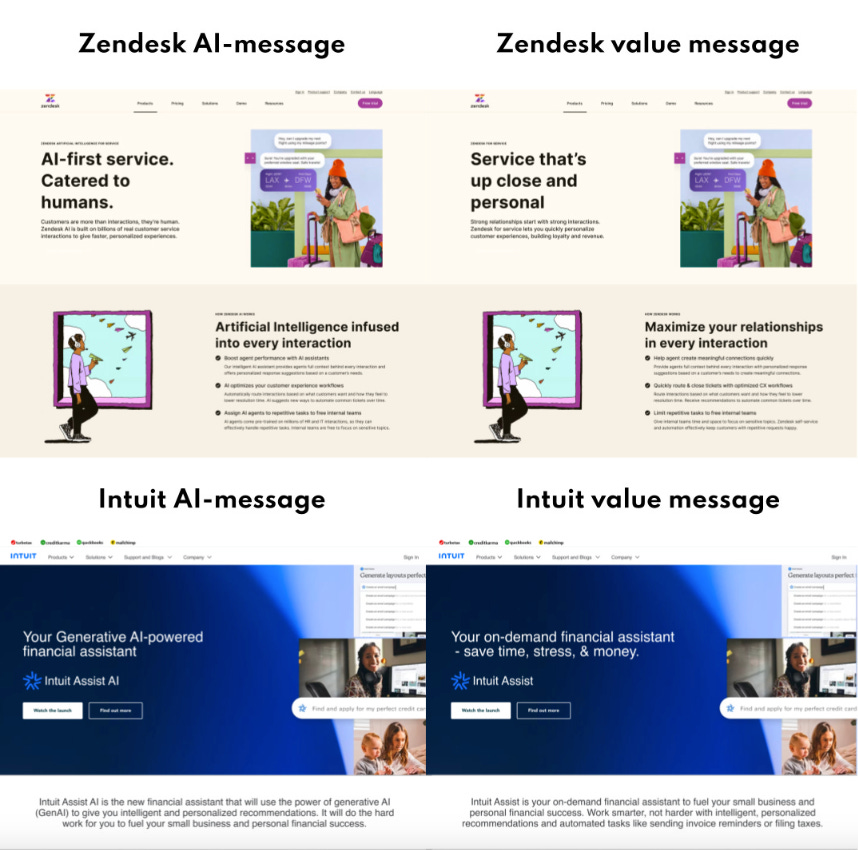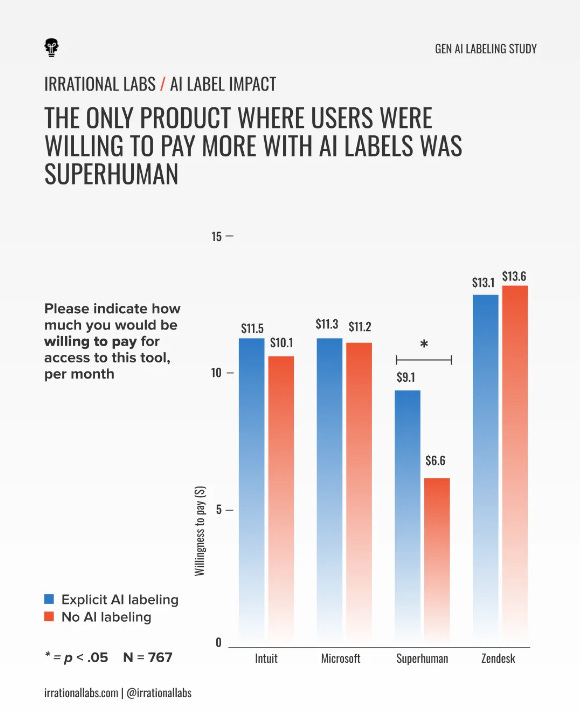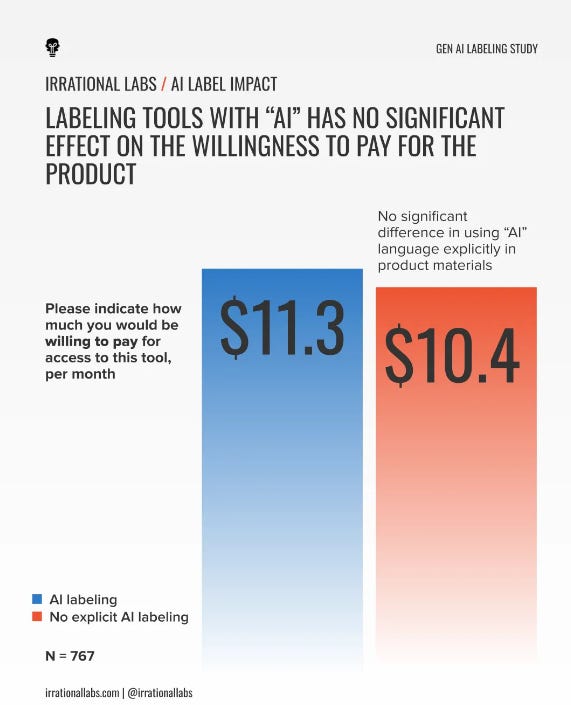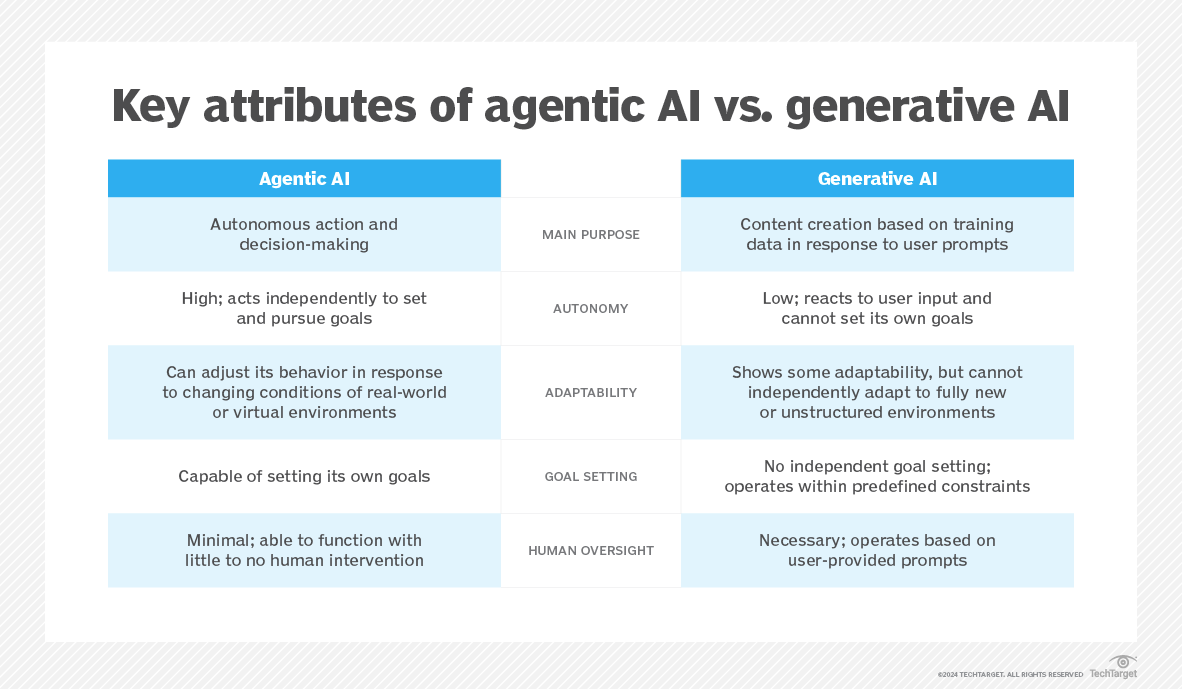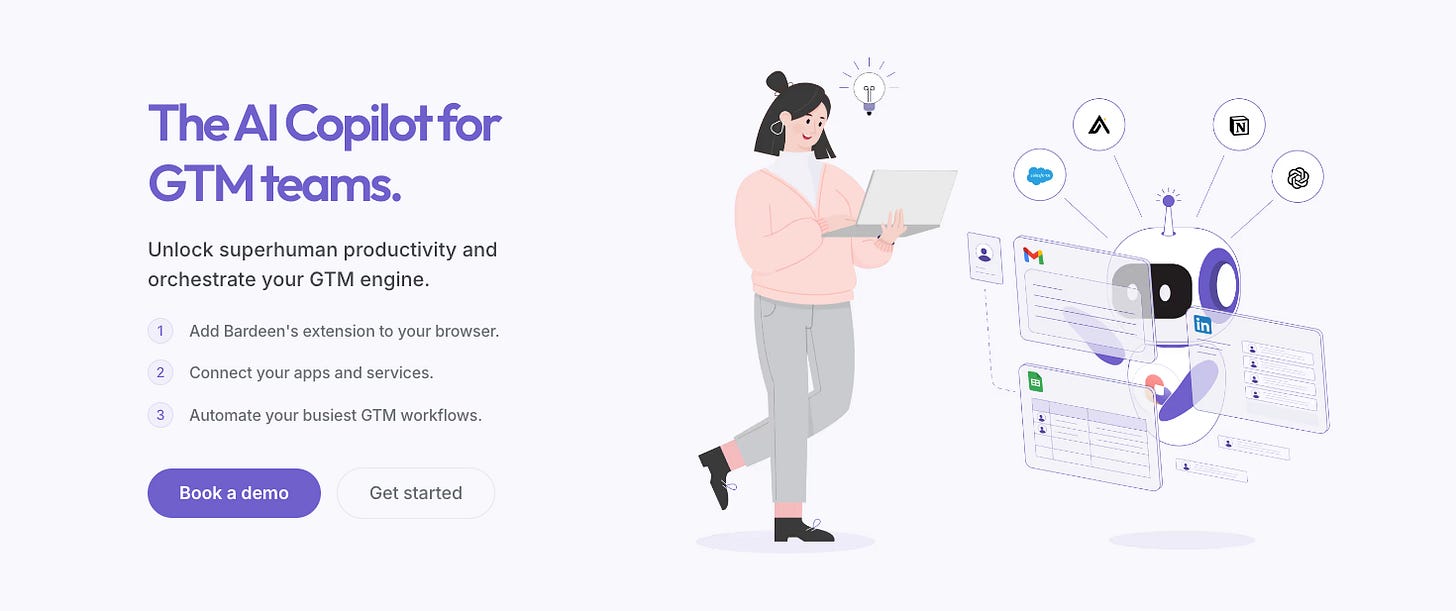02/05/2025: Andrew with HUMANX Event, AI Copyright, Deep Research Comparison, Customers Don't care about AI feature, Top 8 2025 AI Trends, Bardeen.ai
First a poll! Let me know, how do you like the format of the newsletter. Do you like the in depth articles and reviews? Want them shorter? Want other topics? Let me know your feedback!
For those of you new to the newsetter, WELCOME. We have 2 tiers, the free newsletter which is below and the focus is on news and trends with deep dives into tech every week and the paid version which goes more in depth and also we give away access to CustomGPTs, advanced prompting, and mini courses to help you along the way.
You can also join the Slack community where we share updates and news all the time
You can also listen to my lovely AI friends talking through this weeks newsletter here:
This week we have the following:
Season 2, Episode 5 with Andrew Blum CoFounder of HumanX, the Largest AI conference in 2025
GTM AI Tool of the week: Bardeen AI
And the features in the free newsletter this week are:
AI Copyright Law
Deep Research head to head Google vs OpenAI
Customers don’t care about “AI-Powered” feature report
Top 8 2025 Trends from TechTarget
With that being said, lets get into the podcast!
You can go to Youtube, Apple, Spotify as well as a whole other host of locations to hear the podcast or see the video interview.
Inside the Future of AI Events: How HumanX is Revolutionizing AI Conferences
Before we dive in, here is a special offer from Andrew about HumanX exclusively for our subscribers:
Calling All Directors, VPs, and C-Level Executives at Large Companies
I’m thrilled to extend a special, complimentary invitation to join our SolutionBridge program, an exclusive opportunity at HumanX:
Connect with tailored vendors in 8 pre-set, double-opt 15-minute meetings.
Join an elite lineup featuring leaders like the CPO of OpenAI, CEO of Snowflake, and VP of AI at AWS.
$3,995 registration fee waived for qualified buyers.
Don’t miss the chance to simplify sourcing and supercharge your AI initiatives. Interested?
Learn more about SolutionBridge: https://lnkd.in/ezSzQZ9v
Apply to join (2 min): https://lnkd.in/e8A7cjNh
Let’s shape the future of AI together.
Podcast Summary
Andrew recounts his journey from early startup ventures—including his experience founding a consumer company that integrated hardware and software—to transitioning into roles at primary venture partners, where he honed his approach to scaling businesses and events. He emphasizes a critical lesson learned early on: the market’s dynamics often outweigh the merits of any single business.
Andrew discusses how his experiences led him to pivot toward AI, a field undergoing rapid change and offering immense potential for businesses. In exploring AI’s deployment in various sectors, he highlights the confusion many business leaders face when attempting to integrate AI into their operations, given the often overwhelming array of vendor-led solutions. Instead, Andrew’s approach with the HumanX event is intentionally independent, avoiding vendor biases. The event is designed to serve as a comprehensive roadmap for businesses aiming to implement AI, featuring:
Keynotes: Delivered by top industry leaders (e.g., the CEOs of Snowflake and Inflection AI) who offer forward-looking perspectives on AI’s role over the next 5–10 years.
Industry-Specific Panels and Fireside Chats: Tailored to address the unique challenges and deployment strategies in fields such as finance, cybersecurity, and healthcare.
Workshops and Roundtables: These sessions enable deep dives into practical case studies and strategies for integrating AI into business operations.
Show Floor and One-to-One Matchmaking: Designed to connect buyers with vendors, ensuring that attendees can immediately explore solutions, request proposals, and derive tangible ROI from the event.
Andrew also gets into the leadership challenges surrounding AI adoption. He stresses that while CTOs and CIOs are pivotal in establishing the technical infrastructure (data management, pipelines, compliance), real success depends on a cultural shift that encourages sharing of use cases and bottom-up innovation. In his own workflow, he leverages AI tools like ChatGPT to jumpstart creative processes and streamline routine tasks, underscoring that the biggest hurdle is often just getting started.
Furthermore, the discussion touches on practical event logistics such as ticket pricing—with early registration incentives and special rates for startups—and the innovative use of AI within the event itself, from natural language processing for matchmaking to live content summarization and translation. Throughout the conversation, Andrew’s insights position the HumanX event as a must-attend gathering for business leaders and innovators looking to harness AI in a way that transcends traditional, vendor-led industry events.
Bullet Points of Discussion
Andrew Blum’s Journey:
Transition from founding startups to taking on roles at primary venture partners.
Key insight: “The market matters a lot more than the individual business itself.”
Pivot to AI:
Observations on the rapidly evolving AI landscape and the confusion among business leaders regarding effective adoption.
Recognition that traditional vendor-led events are limited by inherent biases.
Event Strategy:
Scaling an event from the outset by planning for a large audience (starting at 3,500 attendees in Las Vegas).
Incorporation of multiple session formats: keynotes, industry-specific panels, workshops, and networking through one-to-one matchmaking.
Differentiating the Event:
Combining the best elements of academic, thought leadership, and vendor ecosystem events to deliver actionable insights.
Emphasis on an independent perspective free from vendor bias.
Leadership and AI Adoption:
The dual importance of robust data infrastructure (managed by CTOs/CIOs) and a culture that encourages sharing practical AI use cases.
Discussion on how AI tools can empower individuals across all business functions.
Practical AI Use Cases:
Andrew’s personal use of ChatGPT and other AI tools to overcome the challenge of “getting started.”
Utilizing AI for summarizing event content, facilitating matchmaking, and enhancing internal communication.
Event Logistics and Pricing:
Ticket pricing details, early bird incentives, and special rates for startups and buyers with budget authority.
Quotes from Andrew Blum
“My biggest takeaway was that the market matters a lot more than the individual business itself.”
“Rising tide lifts all boats.”
“If you're not encouraged to share use cases and openly speak about the stuff that you're doing, your company is not going to benefit from it.”
“The best part about AI for me is that the hardest thing of any task is getting started.”
“I always have ChatGPT open. I'm always like, 'Okay, let me throw this in and get a first draft,' which usually gets me 50% of the way there.”
Copyright and AI created work has been a hot topic over 2024, and we finally have the final say from the US Copyright office.
AI can’t own copyright, and prompts alone don’t make you an author. The U.S. Copyright Office just made that crystal clear. If AI generates something with minimal human input, it’s not protected. But if you modify, arrange, or enhance AI-generated content in a way that shows real creative control, you might have a claim. For GTM leaders, this matters—AI can streamline content creation, but without human authorship, there’s no legal moat. The takeaway? Use AI as a tool, not a crutch. If you want exclusivity, make sure there's real human craftsmanship in the final product.
Key Takeaways:
AI-Generated Works Are Not Copyrightable:
The report reaffirms that purely AI-generated content cannot receive copyright protection under U.S. law. Copyright requires human authorship and creative control.
Prompts alone do not establish authorship since they are instructions, not expressive content.
Human Contributions Can Be Copyrightable:
If a human modifies, arranges, or creatively integrates AI-generated content, the human-authored portion can be protected.
Selection, coordination, and arrangement of AI-generated elements can qualify for copyright protection if they show sufficient originality.
Expressive inputs, such as an original drawing fed into an AI system, may also be protected if the human-authored portion is clearly perceptible.
Legal Clarity on AI as a Tool vs. Stand-in:
AI assisting in creativity (e.g., using AI for photo editing, music mixing, or brainstorming) does not affect copyrightability.
AI fully generating a work without meaningful human intervention is not copyrightable.
No Legislative Change Needed:
The U.S. Copyright Office sees no need for new laws to address AI-generated content. Existing copyright law is seen as sufficient.
Other countries (EU, China, Japan, Korea) generally agree that human authorship is required for copyright.
Incentives and Economic Impact:
Some stakeholders argue that extending copyright to AI-generated works would encourage more content creation.
However, many expressed concern that doing so could undermine human creativity and flood markets with AI-generated material, reducing incentives for human authors.
The Line Between Prompting and AI-Assisted Creation
The difference between merely prompting AI for an output and AI-assisted creation comes down to human control, authorship, and creative decision-making. The U.S. Copyright Office and courts use three key factors to determine whether a human’s contribution qualifies for copyright protection:
1️⃣ Prompting Alone (Not Copyrightable) → AI as the Primary Creator
What Happens?
A user enters text-based prompts into an AI system (e.g., "A futuristic city skyline at sunset, hyper-realistic").
The AI interprets the prompt based on its training data and generates an output.
The user selects the best version but does not modify or contribute further.
Why Isn't This Copyrightable?
The user is not guiding execution, just requesting a result.
The AI is making the expressive choices: composition, structure, and artistic style.
The process is more akin to "ordering from a menu" than actual authorship.
Example (Prompting Alone)
Prompt: "A sci-fi landscape with neon lights and flying cars in cyberpunk style, ultra-HD."
💡 Not Copyrightable because:
The user just described an idea, and AI generated the actual expression.
The output could be radically different each time, even with the same prompt.
2️⃣ AI-Assisted Creation (Potentially Copyrightable) → Human as the Primary Creator
What Happens?
The user modifies, arranges, or enhances AI-generated content.
The human contribution is perceptible and significant—not just a final selection.
The AI acts as a tool rather than the primary creator.
Why Might This Be Copyrightable?
The human exercises control over execution, not just conception.
If a human significantly alters, edits, or combines AI outputs, it may qualify as original work.
Selection, arrangement, and modification of AI-generated materials can show creativity.
Examples (AI-Assisted Creation)
✅ Using AI as a tool for enhancement
A human draws a sketch, feeds it into AI, and refines details manually.
A user generates multiple AI images, combines elements manually in Photoshop, and adds unique touches.
✅ Creative Selection & Arrangement
A comic book artist uses AI to generate multiple backgrounds, but carefully arranges and modifies them in a layout that expresses their vision.
A songwriter uses AI to generate melodies, but selects, rearranges, and edits them into a final composition.
✅ Substantive Human Modifications
AI generates a 1,000-word draft, and the user rewrites significant portions, restructures, and infuses unique insights.
AI generates a portrait, and the user edits facial expressions, refines features, and modifies lighting.
💡 Potentially Copyrightable if:
The final work contains clear, original human authorship.
The AI output is just one part of the process, not the final product.
3️⃣ The “Grey Area” → When Is It AI-Assisted vs. AI-Generated?
To determine if something is AI-assisted vs. AI-generated, ask these questions:
FactorAI-Generated (Not Copyrightable)AI-Assisted (Copyrightable)Human ExpressionOnly provides a promptActively modifies, refines, or arranges AI contentControl Over OutputNo direct influence over executionDecides placement, composition, and structureUniqueness of WorkOutput is AI-determined, and similar versions can be regeneratedUser shapes the final result in a way AI alone wouldn’t createLevel of AI ContributionAI determines most of the outputAI is a tool, not the creator
Litmus Test: Could Someone Else Get a Similar Result by Using the Same AI?
YES? → AI-generated (Not copyrightable)
NO? → AI-assisted (Might be copyrightable)
The Key Is Human Authorship
Prompting alone = AI-created, not copyrightable. The AI is the one making expressive decisions.
Significant human control = AI-assisted, potentially copyrightable. If the human meaningfully modifies, arranges, or enhances AI output, it may qualify for protection.
💡 If AI is your “paintbrush,” you’re the artist. But if AI is your "factory," you’re just ordering a product.
Would you like a checklist or framework for ensuring AI-assisted content is legally protected?
Deep Research Battle: Google vs OpenAI
The AI research landscape is rapidly evolving, with OpenAI and Google leading the charge in autonomous deep research tools. Both companies offer AI-powered research assistants designed to automate knowledge gathering, but they take very different approaches in how they deliver insights.
For GTM professionals, this shift means faster market analysis, smarter decision-making, and automated intelligence gathering, but choosing the right AI tool is crucial for maximizing value. Here’s a deep dive into how OpenAI Deep Research and Google Gemini Deep Research compare, and how GTM teams can leverage them effectively.
So which one do you use?
GTM Implications: Which AI Research Tool Fits Your Needs?
For deep, strategic research & decision-making → OpenAI Deep Research
For fast competitive analysis & structured insights → Google Gemini Deep Research
For cost-sensitive teams that need quick summaries → Google Gemini
For AI-powered market research with rich insights → OpenAI Deep Research
How OpenAI Deep Research Enhances GTM Strategy
1. Advanced Competitive Intelligence & Market Analysis
What It Does:
Conducts multi-step research into competitor strategies, pricing models, and customer sentiment.
Processes diverse formats (PDFs, spreadsheets, financial reports) for a holistic analysis.
Generates expert-level summaries that provide deeper insights than simple search results.
GTM Impact:
✅ Faster, more comprehensive competitive analysis → Instead of manually reviewing market reports, teams can receive AI-generated insights in minutes.
✅ Better product positioning → Identify gaps in the market and adjust messaging accordingly.
✅ Investor & board reporting → AI-generated research can support M&A strategy, investment decisions, and expansion planning.
2. AI-Powered Sales Enablement & Account Research
What It Does:
Summarizes customer insights, pain points, and industry trends for sales teams.
Identifies high-value accounts by analyzing market fit and business needs.
Generates customized sales playbooks based on real-time industry data.
GTM Impact:
✅ More targeted prospecting → Sales reps receive data-driven insights before engaging with leads.
✅ Higher conversion rates → AI-powered messaging ensures that outreach is timely, relevant, and informed.
✅ Strategic account-based marketing (ABM) → Teams can create hyper-personalized sales decks using AI-researched insights.
3. Deep Financial & Economic Analysis for Decision-Makers
What It Does:
Processes macroeconomic trends, financial reports, and risk assessments to inform business strategy.
Cross-references global economic data to identify market expansion opportunities.
Uses Python integration to generate charts, forecasts, and economic impact models.
GTM Impact:
✅ Faster, data-driven decision-making → AI delivers accurate financial insights for pricing, investment, and market entry strategies.
✅ Risk mitigation → Identify potential economic downturns or policy changes affecting global markets.
✅ Optimized forecasting → AI-assisted financial modeling helps GTM leaders anticipate shifts in demand and consumer behavior.
How Google Gemini Deep Research Enhances GTM Strategy
1. Quick Competitive & Industry Trend Analysis
What It Does:
Analyzes search trends, competitor moves, and emerging industry shifts in under 15 minutes.
Produces structured, digestible insights perfect for quick decision-making.
GTM Impact:
✅ Faster insights for marketing campaigns → Helps teams pivot based on emerging consumer trends.
✅ Better SEO & content marketing → AI-generated research can identify high-value keywords and trending topics.
✅ Efficient, high-level reporting → Useful for CMO-level briefings on market conditions.
2. AI-Assisted Product & Customer Research
What It Does:
Extracts insights from customer reviews, social media trends, and surveys.
Delivers structured reports on customer sentiment, pain points, and preferences.
GTM Impact:
✅ Improved customer segmentation → Helps refine buyer personas for targeted outreach.
✅ Optimized product-market fit → AI-powered insights help teams adjust features and messaging based on real-time customer needs.
✅ Better customer success strategies → AI can preemptively identify retention risks and engagement opportunities.
Final Verdict: Which AI Research Tool Is Best for GTM?
If your GTM team prioritizes depth, strategic planning, and high-stakes decision-making, OpenAI Deep Research is the best choice. Its ability to synthesize large datasets, conduct iterative research, and generate professional-grade reports makes it ideal for industries where precision and reliability are crucial.
However, if your team needs quick research insights, structured summaries, and fast decision-making, Google Gemini Deep Research provides a cost-effective alternative that delivers fast and actionable findings—perfect for fast-moving marketing teams and competitive intelligence.
Key Takeaways for GTM Teams:
Use OpenAI Deep Research for high-value, data-driven strategy development.
Use Google Gemini Deep Research for real-time competitive tracking and market trend analysis.
Integrate AI research tools into sales enablement to improve prospecting and account targeting.
Leverage AI to optimize customer segmentation, pricing models, and content marketing strategies.
Monitor AI research trends to adapt go-to-market strategies based on evolving capabilities.
The choice between OpenAI and Google Gemini Deep Research depends on your team’s need for depth, speed, or cost efficiency. Choose wisely, and let AI supercharge your decision-making.
Had a fascinating repot from Kyle’s newsletter and with Kristen Berman from Irrational Labs, a behavioral design consulting group.
Why AI Labels Are Failing and What GTM Teams Can Learn from It
Many businesses believe that leading with “AI-powered” in their branding will increase trust, justify premium pricing, and boost customer interest. However, the data shows otherwise. Berman’s research suggests that for most consumers, the AI label does little to enhance product perception—and in some cases, it even lowers expectations.
For Go-to-Market (GTM) teams, this insight is a wake-up call. Instead of relying on AI buzzwords, teams must shift focus toward communicating real user benefits. Here’s a breakdown of the key findings and how GTM professionals can adapt their messaging strategies for higher engagement, better conversions, and stronger market positioning.
Key Findings: Why AI Labels Don’t Work Like You Think
Berman’s study surveyed 767 participants, comparing reactions to product descriptions with and without AI mentions. The results challenge many assumptions about how customers perceive AI-powered products.
1. “AI-Powered” Lowers Performance Expectations
💡 The Assumption: AI branding signals innovation, intelligence, and superior performance.
⚠️ The Reality: Adding “AI-powered” to a product description actually lowered perceived performance.
Why?
Consumers are increasingly skeptical of AI hype, thanks to overpromising and underdelivering (e.g., unreliable chatbots, poor AI-generated content).
Many now associate AI with inconsistency rather than reliability.
AI tools are prone to “hallucinations” and errors, making users cautious about trusting their capabilities.
GTM Takeaway:
✅ Don’t rely on “AI” as the value proposition—focus on the outcome AI delivers instead. Instead of saying, "AI-powered customer support," say, "Get answers 5x faster with automated customer support."
2. AI Branding Does Not Justify Higher Prices
💡 The Assumption: AI makes a product more valuable, allowing businesses to charge premium pricing.
⚠️ The Reality: Consumers are not willing to pay more just because a product is AI-powered.
The Data:
AI branding did not increase willingness to pay—unless it was explicitly tied to a proven benefit.
Superhuman, an AI-powered email tool, was the only exception, possibly because AI explains why it’s called Superhuman—reinforcing its premium positioning.
GTM Takeaway:
✅ Tie AI to a quantifiable benefit. Instead of "AI-driven automation," use "Cuts email response time by 50%."
✅ Use AI to explain differentiation, not as the selling point itself.
3. AI Mentions Do Not Increase Trust
💡 The Assumption: AI branding makes a product appear more advanced and reliable.
⚠️ The Reality: AI did not increase trust—and in some cases, it created doubt.
Why?
Consumers don’t see AI as inherently trustworthy.
Some associate AI with automation that removes human oversight, making them less confident in the product’s reliability.
GTM Takeaway:
✅ If AI is part of your product, highlight transparency and control. Instead of "AI-powered decision-making," try "AI recommendations with full human oversight."
Why Companies Overuse AI Labels (And Why They Should Stop)
If AI branding doesn’t build trust or justify higher pricing, why do companies keep using it?
Investor Pressure: AI branding is often used to boost valuations and attract funding, even if customers don’t respond to it.
SEO Optimization: AI-labeled branding helps capture search traffic from AI-related queries.
Fear of Falling Behind: Companies overemphasize AI because competitors are doing it, rather than because customers care.
The Problem:
This strategy disconnects brands from their users. When AI is treated as the product’s value, rather than the tool that powers it, businesses risk losing credibility and engagement.
How GTM Teams Should Market AI Features (Without Overhyping Them)
So how do you sell AI-powered products effectively without falling into the “AI-powered” trap? Berman’s research suggests four better ways to communicate AI’s value.
1. Lead with Benefits, Not Jargon
What customers care about: What’s in it for them.
Instead of:
🚫 “AI-powered workflow automation.”
Use:
✅ “Reduce manual data entry by 80% and focus on high-impact work.”
Example:
Apple iPod: Instead of advertising “1GB of storage,” Apple marketed “1,000 songs in your pocket.”
Notion AI: Uses the tagline “Think it. Make it.” instead of emphasizing AI.
2. Make Productivity Gains Tangible
What customers care about: How much time, effort, or money they’ll save.
Instead of:
🚫 “AI-driven email filtering for better productivity.”
Use:
✅ “Spend 50% less time sorting emails—focus on what matters.”
Example:
GitHub Copilot: Promotes that developers code 55% faster instead of just mentioning AI.
3. Leverage the Endowment Effect
What customers care about: Feeling like the product is already theirs.
Instead of:
🚫 “Try our AI-powered assistant today!”
Use:
✅ “Your first five AI-powered reports are free—experience the difference.”
Example:
Grammarly & Notion AI: Users get limited free access before paying—creating a sense of ownership and value before commitment.
4. When You Must Say “AI,” Be Thoughtful
What customers care about: Clear explanations, not hype.
Instead of:
🚫 “AI-powered customer support.”
Use:
✅ “Smart automation helps resolve tickets 2x faster, with human support when needed.”
Example:
Google Lens: Doesn’t just say “AI-powered vision.” It explains how it “helps you see and analyze the world.”
Spotify DJ: Uses AI but frames it as a personal music curator, not just an AI feature.
Final Thoughts: What GTM Teams Must Do Next
Key Takeaways for AI Marketing:
✅ AI is not the product—it’s the tool that powers real benefits.
✅ Customers don’t automatically trust AI—highlight transparency and control.
✅ Make AI-powered productivity tangible (time saved, efficiency gained).
✅ If using “AI” in branding, ensure it adds real meaning to the message.
For GTM teams, this research offers a clear roadmap:
📌 Reevaluate AI branding—does it help or hurt engagement?
📌 A/B test AI vs. benefit-driven messaging to see what resonates.
📌 Refocus marketing strategies on tangible, outcome-driven benefits.
🚀 In a world obsessed with AI, the real winners will be the companies that sell impact—not buzzwords.
8 AI and Machine Learning Trends for 2025 from TechTarget: What They Mean for GTM Strategy
As AI continues to evolve at an unprecedented pace, 2025 is set to be a critical year for adoption, refinement, and regulation. Sequoia’s AI trends report outlines how the industry is shifting from hype to execution, emphasizing practical applications, domain-specific models, and security concerns.
For GTM teams, these trends signal new opportunities and challenges—from adapting AI marketing strategies to integrating AI-powered automation into sales, marketing, and customer engagement. Here’s how each trend impacts GTM strategy and what businesses should do to stay ahead.
1. AI Moves Beyond Hype: Companies Demand Real ROI
💡 The Trend:
After two years of excitement, businesses are now demanding measurable outcomes from AI investments. Companies are shifting from early-stage experimentation to proven, scalable applications that reduce costs and improve efficiency.
🚀 GTM Impact:
✅ AI vendors must prove ROI → Messaging must focus on measurable success stories, cost savings, and efficiency gains.
✅ Pilot projects must move to full deployment → GTM teams must help customers integrate AI into real-world workflows, rather than selling AI for AI’s sake.
✅ Marketing must shift away from AI buzzwords → AI-powered products need business-focused positioning, not just “AI-powered” branding.
2. AI is Moving Beyond Chatbots: Multimodal AI is the Future
💡 The Trend:
Companies are moving away from chat-based AI to applications that use LLMs in the background for text, video, voice, and image-based automation.
🚀 GTM Impact:
✅ Marketing and content teams must integrate multimodal AI → AI-driven video generation (like OpenAI’s Sora) will disrupt how brands create and distribute content.
✅ Sales teams will use AI video and voice agents → AI-powered video assistants can personalize customer interactions, record insights from calls, and generate follow-up emails automatically.
✅ AI-powered search and knowledge management tools will rise → GTM teams should explore how AI-enhanced search engines can improve customer research, onboarding, and retention.
3. AI Agents Will Revolutionize Automation
💡 The Trend:
The rise of agentic AI models—such as Salesforce Agentforce—will allow AI to handle complex workflows autonomously. AI will not just assist but actively take action on behalf of users, managing schedules, processing data, and completing multi-step business tasks.
🚀 GTM Impact:
✅ Customer success teams must embrace AI-powered automation → AI agents can proactively resolve customer issues, manage renewals, and handle basic troubleshooting.
✅ Sales teams can automate deal cycles → AI agents can score leads, send follow-ups, and even negotiate pricing, reducing manual workload.
✅ AI-driven process automation will be a major GTM selling point → Companies that automate operations with AI agents will have a competitive advantage in efficiency and scalability.
4. AI Models Are Becoming Commodities: Differentiation is Key
💡 The Trend:
With five major LLM providers (OpenAI, Google, Meta, Anthropic, xAI) reaching performance parity, the market is shifting from which model is best to which offers the best integrations, UX, and pricing.
🚀 GTM Impact:
✅ Enterprise buyers will choose AI tools based on usability, not model size → GTM teams must highlight seamless integrations (CRM, analytics, marketing automation).
✅ The race for differentiated AI services is heating up → Companies must develop custom models and fine-tuned AI assistants tailored to industry-specific needs.
✅ GTM teams should shift focus from raw AI power to business impact → The best AI tools will be the ones that simplify workflows, reduce costs, and improve decision-making.
5. AI Will Become More Domain-Specific
💡 The Trend:
AI is shifting away from general-purpose models toward industry-specific applications in finance, healthcare, law, and cybersecurity.
🚀 GTM Impact:
✅ Vertical AI solutions will dominate enterprise adoption → AI-powered legal research tools, healthcare diagnosis models, and financial risk predictors will see mass adoption.
✅ GTM teams should refine ICP (Ideal Customer Profile) targeting → AI buyers will expect tailored solutions, meaning hyper-targeted messaging and use cases will be required.
✅ Custom AI deployments will be a key revenue stream → Businesses will fine-tune models for their needs, creating demand for AI customization and consulting services.
6. AI Literacy Will Be a Competitive Differentiator
💡 The Trend:
Companies need employees who understand AI, not just developers who build it. AI literacy training is becoming essential across all functions.
🚀 GTM Impact:
✅ Sales & marketing teams must educate customers → Buyers will expect AI onboarding, training, and enablement.
✅ AI-powered training platforms will surge in demand → Companies must invest in AI learning tools for employees.
✅ AI adoption will be slower in companies with knowledge gaps → GTM teams must position “AI education” as part of the sales cycle to remove barriers to adoption.
7. AI Regulation is Unclear—But Companies Must Prepare
💡 The Trend:
While the EU’s AI Act is shaping regulations, the U.S. remains largely unregulated under the new administration. However, large companies may self-regulate to avoid backlash.
🚀 GTM Impact:
✅ Companies must align AI deployments with ethical best practices → Transparency, data privacy, and bias mitigation will be required for enterprise adoption.
✅ AI governance tools will be a growing market opportunity → Compliance-focused AI solutions will become must-have software for regulated industries.
✅ GTM teams must be prepared for sudden regulatory changes → AI strategy must remain flexible to accommodate future legal requirements.
8. AI-Powered Security Threats Will Surge
💡 The Trend:
As AI becomes more sophisticated, so do cybercriminals. AI-generated deepfakes, phishing scams, and data poisoning attacks are becoming serious concerns.
🚀 GTM Impact:
✅ Security-focused AI solutions will be in high demand → Companies that offer AI-driven fraud detection, identity verification, and cybersecurity tools will gain a competitive edge.
✅ Businesses must strengthen internal security policies → GTM teams should highlight security features as a key selling point.
✅ Regulated industries will demand AI risk assessments → AI vendors selling to finance, healthcare, and government agencies must ensure security compliance and auditability.
Final Thoughts: GTM Strategy for an AI-Driven 2025
Sequoia’s AI in 2025 report makes one thing clear: AI is no longer experimental—it’s now an execution game.
GTM Teams Must Adapt to These Trends:
✅ AI must prove ROI—hype is not enough.
✅ AI search and multimodal models are the next big use cases.
✅ AI adoption will be industry-specific—verticalized AI will win.
✅ Regulation and security concerns will impact AI adoption.
✅ AI literacy is a differentiator—companies that train their teams will win.
🚀 For GTM teams, success in 2025 depends on how well they pivot from AI hype to real-world business outcomes. Companies that educate customers, fine-tune AI for specific use cases, and integrate AI seamlessly into workflows will lead the next wave of AI adoption.
GTM AI Tech of the week: BARDEEN.AI
To be clear, this is not a sponsored post, I find cool tech and want to share, I have no affiliation with Bardeen besides knowing that it exists.
Bardeen AI is an advanced automation platform designed to streamline workflows by connecting various applications and automating repetitive tasks directly within the browser. It empowers users to create custom workflows without the need for coding, enhancing productivity across multiple domains.
Key Features:
Magic Box: This feature allows users to describe their desired automation in everyday language, which Bardeen then translates into automated workflows. This no-code approach makes automation accessible to non-technical users.
AI Web Scraper: Bardeen's AI-driven web scraper can extract information from websites by navigating through pages, interacting with on-page elements, and copying data into a temporary buffer. It's capable of handling complex websites and dynamic content, making it valuable for tasks like lead generation and market research.
AI Message Generator: This tool enables users to create and personalize messages for emails, social media, and texts. By specifying a recipient's profile, Bardeen can generate tailored content, enhancing outreach efforts in sales and marketing.
Image & PDF Extractor (OCR): Bardeen can extract text, tables, and content from PDF documents or images, which is particularly useful for processing invoices, signed contracts, and other scanned documents.
Meeting Assistant: This feature summarizes meeting notes, decisions, and action items, and integrates them into project management tools like Notion, Asana, or ClickUp, ensuring that key insights are captured and actionable.
Integrations:
Bardeen supports over 100 applications, including popular platforms like Google Sheets, Slack, Zoom, HubSpot, Salesforce, and LinkedIn Sales Navigator. This extensive integration capability allows for seamless data transfer and task management across various tools.
Use Cases:
Sales: Automate lead discovery, CRM entry, and personalized outreach to enhance sales efficiency.
Marketing: Streamline content creation, account-based marketing, and data enrichment to improve campaign effectiveness.
Operations: Automate lead and account intelligence gathering, CRM enrichment, and system integrations to optimize operational workflows.
Customer Success: Maintain up-to-date account information, automate customer communications, and proactively manage relationships to drive customer growth and reduce churn.
Pricing:
Bardeen offers a free plan with basic features and limited credits. For advanced functionalities, such as AI Features+, Scraper, Categorizer, and access to advanced integrations, users can opt for the Pro or Business plans, which provide higher credit allocations and additional capabilities.
How GTM Teams Can Leverage Bardeen AI for Automation and Productivity
Bardeen AI is a no-code automation platform that allows GTM teams to automate repetitive tasks, integrate multiple business tools, and enhance team collaboration. With its Magic Box, AI-powered web scraper, meeting assistant, and workflow integrations, Bardeen is a game-changer for sales, marketing, customer success, revenue operations, and leadership teams.
Here’s how each GTM function can use Bardeen AI to work smarter, save time, and optimize performance.
1. Sales Teams: Automating Lead Generation & CRM Management
💡 Key Pain Points:
Manually sourcing leads from LinkedIn, websites, or databases takes too much time.
Sales reps spend hours inputting data into CRMs instead of selling.
Follow-ups get lost, leading to missed opportunities.
🚀 How Bardeen AI Helps:
✅ Automated Lead Capture & Enrichment → Use Bardeen’s AI Web Scraper to extract lead data from LinkedIn Sales Navigator, Crunchbase, or company websites and populate your CRM automatically.
✅ Instant CRM Entry & Updates → Sync scraped data with HubSpot, Salesforce, or Pipedrive, avoiding manual data entry.
✅ AI-Powered Follow-Ups → Auto-generate personalized outreach emails based on prospect insights.
✅ AI Meeting Assistant → Summarize sales calls and auto-log notes and next steps in your CRM.
🔹 Real-World Use Case:
A sales rep researching new leads on LinkedIn can use Bardeen’s one-click automation to pull prospect names, job titles, and company details, log them into Salesforce, and schedule a follow-up task in seconds.
2. Marketing Teams: AI-Powered Content & Data Automation
💡 Key Pain Points:
Gathering competitor insights and market data is time-consuming.
Content creation and personalization take too long.
Managing marketing operations across multiple platforms is inefficient.
🚀 How Bardeen AI Helps:
✅ Competitive Intelligence & Market Research → Use Bardeen’s Web Scraper to monitor competitors’ content, ads, and pricing changes automatically.
✅ Content Repurposing & Personalization → AI Message Generator helps tailor ad copy, emails, and blog posts to different audience segments.
✅ Marketing Attribution & Data Syncing → Auto-sync campaign data from Google Analytics, HubSpot, and spreadsheets for easier reporting.
✅ Event & Webinar Follow-Ups → Automatically scrape attendee lists, draft follow-up emails, and push data to your CRM.
🔹 Real-World Use Case:
A content marketer can use Bardeen to monitor industry trends, extract the latest news articles, and generate AI-powered blog post drafts—reducing time spent on research and ideation.
3. Revenue Operations (RevOps): Automating Data Management & Reporting
💡 Key Pain Points:
Data inconsistencies across systems lead to inaccurate reporting.
CRM hygiene is difficult to maintain with manual updates.
Pulling real-time reports across tools requires manual work.
🚀 How Bardeen AI Helps:
✅ Data Syncing Across Platforms → Keep Salesforce, Google Sheets, HubSpot, and Looker reports aligned in real time.
✅ Automated CRM Cleanup → Flag duplicate entries, incomplete records, and outdated contacts in CRMs.
✅ Scheduled AI-Powered Reports → Generate and send automated reports for pipeline health, sales activity, and revenue trends.
✅ AI Meeting Summaries for RevOps Reviews → Capture key discussions from sales meetings and log insights for data-driven forecasting.
🔹 Real-World Use Case:
A RevOps manager can set up Bardeen to automatically check CRM entries for missing fields, update records, and sync data into dashboards—ensuring leadership has accurate sales forecasting at all times.
4. Customer Success: AI-Enhanced Client Management & Engagement
💡 Key Pain Points:
Account managers struggle to track customer health signals across multiple systems.
Customer interactions and feedback get lost in different tools.
Renewals and upsell opportunities often go unnoticed.
🚀 How Bardeen AI Helps:
✅ Customer Health Monitoring → Track engagement levels from support tickets, product usage, and NPS surveys.
✅ Automated Meeting Notes & Summaries → Capture customer calls and meetings, extract key insights, and log them in your CRM or customer success platform.
✅ Proactive Renewal & Expansion Alerts → Flag customers at risk of churn or ready for upsell based on behavior trends.
✅ AI-Driven Follow-Ups → Generate personalized check-in messages for customers at key milestones.
🔹 Real-World Use Case:
A Customer Success Manager can use Bardeen to automatically pull product usage data, identify low-engagement accounts, and trigger outreach messages before customers churn.
5. Leadership & Strategy Teams: AI-Powered Business Intelligence
💡 Key Pain Points:
Decision-making is slowed down by manual data aggregation.
Leadership struggles to get real-time insights from sales, marketing, and customer data.
Meeting summaries and action items take too long to process.
🚀 How Bardeen AI Helps:
✅ Automated Market & Competitor Tracking → Get real-time updates on industry trends, funding news, and competitor moves.
✅ AI-Powered Business Reports → Generate daily or weekly AI-driven summaries on sales, marketing, and revenue performance.
✅ AI Meeting Recaps & Action Items → Summarize executive meetings, highlight key decisions, and track follow-up tasks in Notion, Slack, or Asana.
✅ Custom Workflow Automation for Strategic Initiatives → Automate internal knowledge-sharing and keep stakeholders aligned.
🔹 Real-World Use Case:
A CRO or VP of Sales can receive a daily automated briefing summarizing sales pipeline updates, customer churn risks, and competitive threats—all powered by AI.
Final Thoughts: Why Bardeen AI is a Must-Have for GTM Teams
Bardeen AI is more than just an automation tool—it’s a strategic enabler for GTM teams looking to optimize efficiency, enhance collaboration, and drive data-driven decision-making.
✅ Key Takeaways for GTM Teams:
✔ Sales Teams → Automate lead generation, CRM enrichment, and follow-ups.
✔ Marketing Teams → Streamline competitive intelligence, content creation, and campaign tracking.
✔ RevOps Teams → Improve data accuracy, reporting automation, and CRM hygiene.
✔ Customer Success Teams → Track customer health, automate check-ins, and predict churn risks.
✔ Leadership → Get real-time insights, automated reports, and strategic AI-driven decision support.
🚀 With Bardeen AI, GTM teams can eliminate manual work, focus on high-impact initiatives, and scale operations effortlessly. If your team isn’t leveraging AI automation yet, Bardeen is the perfect place to start.
In summary, Bardeen AI serves as a powerful tool for individuals and teams aiming to enhance productivity by automating routine tasks and integrating various applications into cohesive workflows.




